Lukáš Burget
DeCRED: Decoder-Centric Regularization for Encoder-Decoder Based Speech Recognition
Aug 12, 2025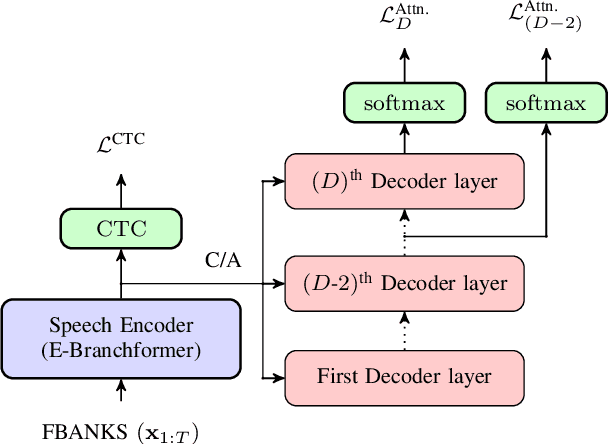
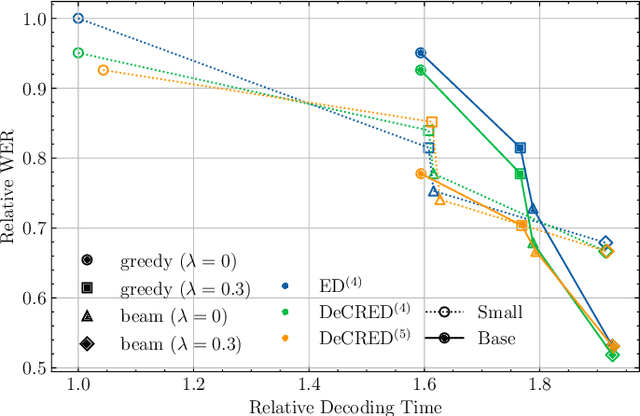

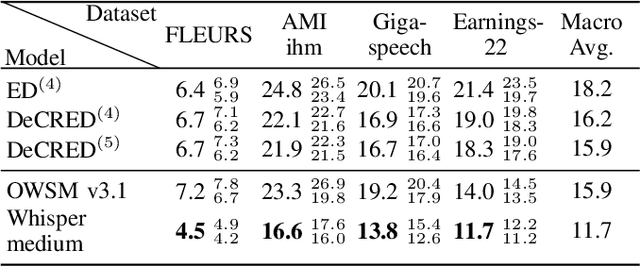
Abstract:This paper presents a simple yet effective regularization for the internal language model induced by the decoder in encoder-decoder ASR models, thereby improving robustness and generalization in both in- and out-of-domain settings. The proposed method, Decoder-Centric Regularization in Encoder-Decoder (DeCRED), adds auxiliary classifiers to the decoder, enabling next token prediction via intermediate logits. Empirically, DeCRED reduces the mean internal LM BPE perplexity by 36.6% relative to 11 test sets. Furthermore, this translates into actual WER improvements over the baseline in 5 of 7 in-domain and 3 of 4 out-of-domain test sets, reducing macro WER from 6.4% to 6.3% and 18.2% to 16.2%, respectively. On TEDLIUM3, DeCRED achieves 7.0% WER, surpassing the baseline and encoder-centric InterCTC regularization by 0.6% and 0.5%, respectively. Finally, we compare DeCRED with OWSM v3.1 and Whisper-medium, showing competitive WERs despite training on much less data with fewer parameters.
BUT System for the MLC-SLM Challenge
Jun 16, 2025Abstract:We present a two-speaker automatic speech recognition (ASR) system that combines DiCoW -- a diarization-conditioned variant of Whisper -- with DiariZen, a diarization pipeline built on top of Pyannote. We first evaluate both systems in out-of-domain (OOD) multilingual scenarios without any fine-tuning. In this scenario, DiariZen consistently outperforms the baseline Pyannote diarization model, demonstrating strong generalization. Despite being fine-tuned on English-only data for target-speaker ASR, DiCoW retains solid multilingual performance, indicating that encoder modifications preserve Whisper's multilingual capabilities. We then fine-tune both DiCoW and DiariZen on the MLC-SLM challenge data. The fine-tuned DiariZen continues to outperform the fine-tuned Pyannote baseline, while DiCoW sees further gains from domain adaptation. Our final system achieves a micro-average tcpWER/CER of 16.75% and ranks second in Task 2 of the MLC-SLM challenge. Lastly, we identify several labeling inconsistencies in the training data -- such as missing speech segments and incorrect silence annotations -- which can hinder diarization fine-tuning. We propose simple mitigation strategies to address these issues and improve system robustness.
Analysis of ABC Frontend Audio Systems for the NIST-SRE24
May 21, 2025Abstract:We present a comprehensive analysis of the embedding extractors (frontends) developed by the ABC team for the audio track of NIST SRE 2024. We follow the two scenarios imposed by NIST: using only a provided set of telephone recordings for training (fixed) or adding publicly available data (open condition). Under these constraints, we develop the best possible speaker embedding extractors for the pre-dominant conversational telephone speech (CTS) domain. We explored architectures based on ResNet with different pooling mechanisms, recently introduced ReDimNet architecture, as well as a system based on the XLS-R model, which represents the family of large pre-trained self-supervised models. In open condition, we train on VoxBlink2 dataset, containing 110 thousand speakers across multiple languages. We observed a good performance and robustness of VoxBlink-trained models, and our experiments show practical recipes for developing state-of-the-art frontends for speaker recognition.
DiCoW: Diarization-Conditioned Whisper for Target Speaker Automatic Speech Recognition
Dec 30, 2024Abstract:Speaker-attributed automatic speech recognition (ASR) in multi-speaker environments remains a significant challenge, particularly when systems conditioned on speaker embeddings fail to generalize to unseen speakers. In this work, we propose Diarization-Conditioned Whisper (DiCoW), a novel approach to target-speaker ASR that leverages speaker diarization outputs as conditioning information. DiCoW extends the pre-trained Whisper model by integrating diarization labels directly, eliminating reliance on speaker embeddings and reducing the need for extensive speaker-specific training data. Our method introduces frame-level diarization-dependent transformations (FDDT) and query-key biasing (QKb) techniques to refine the model's focus on target speakers while effectively handling overlapping speech. By leveraging diarization outputs as conditioning signals, DiCoW simplifies the workflow for multi-speaker ASR, improves generalization to unseen speakers and enables more reliable transcription in real-world multi-speaker recordings. Additionally, we explore the integration of a connectionist temporal classification (CTC) head to Whisper and demonstrate its ability to improve transcription efficiency through hybrid decoding. Notably, we show that our approach is not limited to Whisper; it also provides similar benefits when applied to the Branchformer model. We validate DiCoW on real-world datasets, including AMI and NOTSOFAR-1 from CHiME-8 challenge, as well as synthetic benchmarks such as Libri2Mix and LibriCSS, enabling direct comparisons with previous methods. Results demonstrate that DiCoW enhances the model's target-speaker ASR capabilities while maintaining Whisper's accuracy and robustness on single-speaker data.
Joint Training of Speaker Embedding Extractor, Speech and Overlap Detection for Diarization
Nov 04, 2024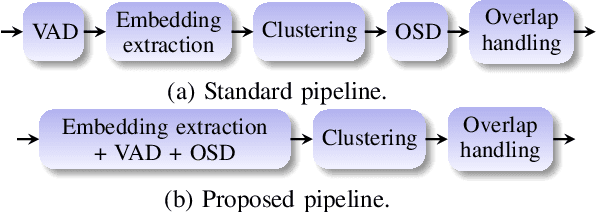
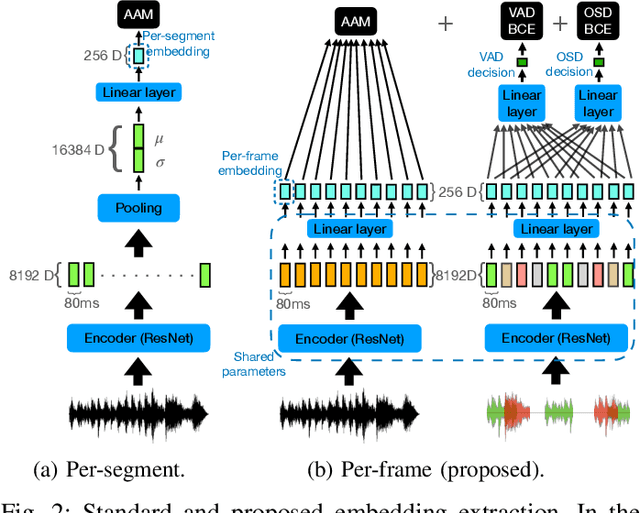

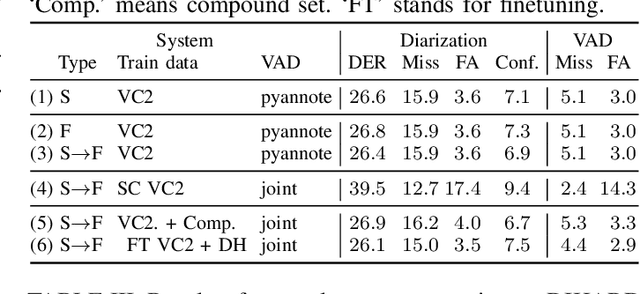
Abstract:In spite of the popularity of end-to-end diarization systems nowadays, modular systems comprised of voice activity detection (VAD), speaker embedding extraction plus clustering, and overlapped speech detection (OSD) plus handling still attain competitive performance in many conditions. However, one of the main drawbacks of modular systems is the need to run (and train) different modules independently. In this work, we propose an approach to jointly train a model to produce speaker embeddings, VAD and OSD simultaneously and reach competitive performance at a fraction of the inference time of a standard approach. Furthermore, the joint inference leads to a simplified overall pipeline which brings us one step closer to a unified clustering-based method that can be trained end-to-end towards a diarization-specific objective.
Improving Automatic Speech Recognition with Decoder-Centric Regularisation in Encoder-Decoder Models
Oct 22, 2024



Abstract:This paper proposes a simple yet effective way of regularising the encoder-decoder-based automatic speech recognition (ASR) models that enhance the robustness of the model and improve the generalisation to out-of-domain scenarios. The proposed approach is dubbed as $\textbf{De}$coder-$\textbf{C}$entric $\textbf{R}$egularisation in $\textbf{E}$ncoder-$\textbf{D}$ecoder (DeCRED) architecture for ASR, where auxiliary classifier(s) is introduced in layers of the decoder module. Leveraging these classifiers, we propose two decoding strategies that re-estimate the next token probabilities. Using the recent E-branchformer architecture, we build strong ASR systems that obtained competitive WERs as compared to Whisper-medium and outperformed OWSM v3; while relying only on a fraction of training data and model size. On top of such a strong baseline, we show that DeCRED can further improve the results and, moreover, generalise much better to out-of-domain scenarios, where we show an absolute reduction of 2.7 and 2.9 WERs on AMI and Gigaspeech datasets, respectively. We provide extensive analysis and accompanying experiments that support the benefits of the proposed regularisation scheme.
State-of-the-art Embeddings with Video-free Segmentation of the Source VoxCeleb Data
Oct 03, 2024



Abstract:In this paper, we refine and validate our method for training speaker embedding extractors using weak annotations. More specifically, we use only the audio stream of the source VoxCeleb videos and the names of the celebrities without knowing the time intervals in which they appear in the recording. We experiment with hyperparameters and embedding extractors based on ResNet and WavLM. We show that the method achieves state-of-the-art results in speaker verification, comparable with training the extractors in a standard supervised way on the VoxCeleb dataset. We also extend it by considering segments belonging to unknown speakers appearing alongside the celebrities, which are typically being discarded. Overall, our approach can be used for directly training state-of-the-art embedding extractors or as an alternative to the VoxCeleb-like pipeline for dataset creation without needing image modality.
Target Speaker ASR with Whisper
Sep 14, 2024Abstract:We propose a novel approach to enable the use of large, single speaker ASR models, such as Whisper, for target speaker ASR. The key insight of this method is that it is much easier to model relative differences among speakers by learning to condition on frame-level diarization outputs, than to learn the space of all speaker embeddings. We find that adding even a single bias term per diarization output type before the first transformer block can transform single speaker ASR models, into target speaker ASR models. Our target-speaker ASR model can be used for speaker attributed ASR by producing, in sequence, a transcript for each hypothesized speaker in a diarization output. This simplified model for speaker attributed ASR using only a single microphone outperforms cascades of speech separation and diarization by 11% absolute ORC-WER on the NOTSOFAR-1 dataset.
BUT Systems and Analyses for the ASVspoof 5 Challenge
Aug 20, 2024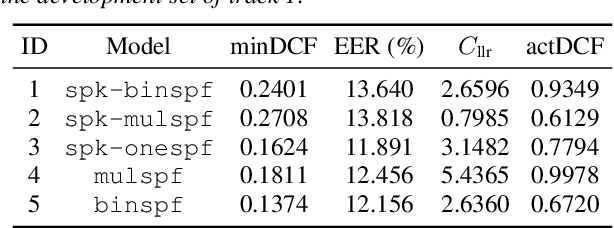
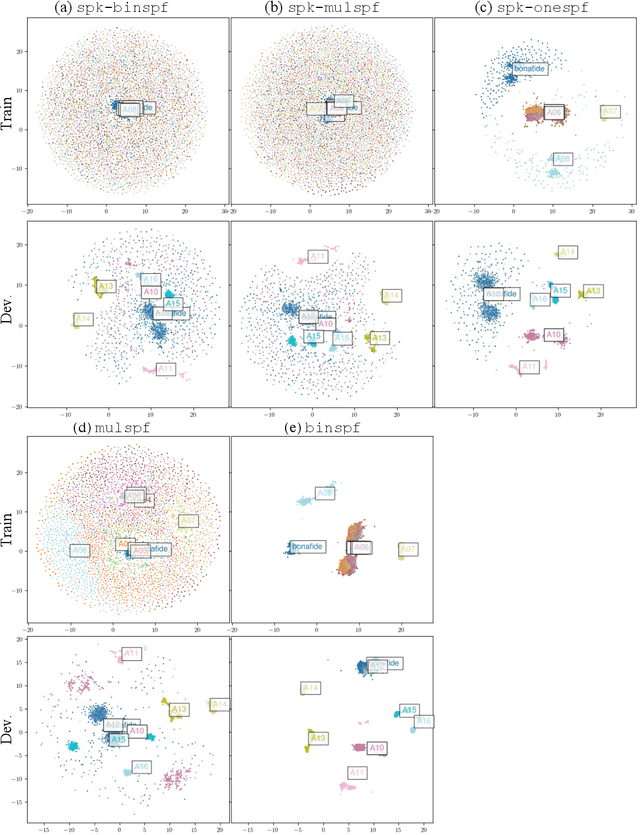
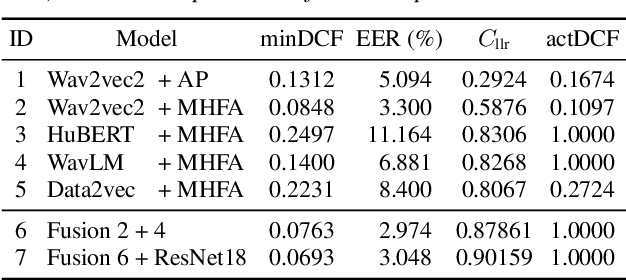
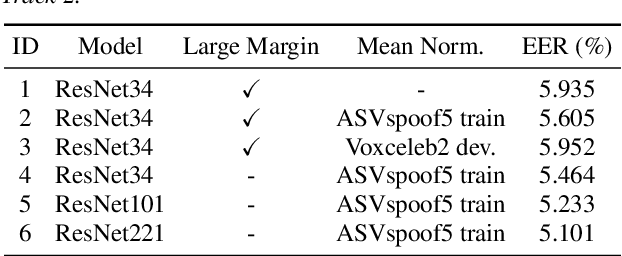
Abstract:This paper describes the BUT submitted systems for the ASVspoof 5 challenge, along with analyses. For the conventional deepfake detection task, we use ResNet18 and self-supervised models for the closed and open conditions, respectively. In addition, we analyze and visualize different combinations of speaker information and spoofing information as label schemes for training. For spoofing-robust automatic speaker verification (SASV), we introduce effective priors and propose using logistic regression to jointly train affine transformations of the countermeasure scores and the automatic speaker verification scores in such a way that the SASV LLR is optimized.
Beyond the Labels: Unveiling Text-Dependency in Paralinguistic Speech Recognition Datasets
Mar 12, 2024



Abstract:Paralinguistic traits like cognitive load and emotion are increasingly recognized as pivotal areas in speech recognition research, often examined through specialized datasets like CLSE and IEMOCAP. However, the integrity of these datasets is seldom scrutinized for text-dependency. This paper critically evaluates the prevalent assumption that machine learning models trained on such datasets genuinely learn to identify paralinguistic traits, rather than merely capturing lexical features. By examining the lexical overlap in these datasets and testing the performance of machine learning models, we expose significant text-dependency in trait-labeling. Our results suggest that some machine learning models, especially large pre-trained models like HuBERT, might inadvertently focus on lexical characteristics rather than the intended paralinguistic features. The study serves as a call to action for the research community to reevaluate the reliability of existing datasets and methodologies, ensuring that machine learning models genuinely learn what they are designed to recognize.
 Add to Chrome
Add to Chrome Add to Firefox
Add to Firefox Add to Edge
Add to Edge